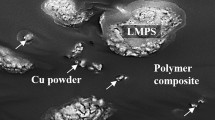Abstract
A novel low-melting-point solder (LMS) and high-melting-point solder (HMS)-filled solderable isotropic polymer composite (LH-SIPC) was developed to enhance the interconnection properties of a solderable isotropic polymer composite (SIPC) containing only LMS filler. To determine the effect of the LMS/HMS (i.e., Sn–58Bi/Sn–3.0Ag–0.5Cu) mixing ratio on the interconnection properties of LH-SIPC joints, LH-SIPCs with different mixing ratios of the LMS/HMS filler were formulated, and an interconnection test using a quad flat package was performed. The LH-SIPC joints having HMS content of less than 90 vol% in the filler formed a wide and stable conduction path through the proper internal flow, coalescence, and wetting behavior of molten fillers within the polymer composite with low viscosity owing to the decreased melting point of HMS caused by the interaction between the molten LMS and solid HMS. Moreover, the mechanical properties of LH-SIPC joints were linearly improved as the HMS content increased because of precipitation hardening and dispersion strengthen effects of the fine Bi phase and intermetallic compound particles distributed in the conduction path and refinement of grain size. However, LH-SIPCs with excessively high HMS content formed a poorly shaped conduction path because of excessive curing of the polymer composite, which resulted in the deterioration of the interconnection properties of the LH-SIPC joint.









Similar content being viewed by others
Data availability
The datasets used or analyzed in this study are available with the corresponding author. They can be produced upon reasonable request.
References
M.J. Yim, Y. Li, K. Moon, K.W. Paik, C.P. Wong, J. Adhes. Sci. Technol. 22, 1593–1630 (2008)
R. Aradhana, S. Mohanty, S.K. Nayak, Int. J. Adhes. Adhes. 99, 102596 (2020)
Q. Wang, S. Zhang, G. Liu, T. Lin, P. He, J. Alloys Compd. 820, 153184 (2020)
S. Xu, D.A. Dillard, J.G. Dillard, Int. J. Adhes. Adhes. 23, 235–250 (2003)
Y. Li, C.P. Wong, Mat. Sci. Eng. R. 51, 1–35 (2006)
B.S. Yim, J.M. Kim, S.H. Jeon, S.H. Lee, J. Kim, J.G. Han, M. Cho, Mater. Trans. 50, 2649–2655 (2009)
B.S. Yim, Y. Kwon, S.H. Oh, J. Kim, Y.E. Shin, S.H. Lee, J.M. Kim, Microelectron. Reliab. 52, 1165–1173 (2012)
B.S. Yim, J.I. Lee, B.H. Lee, Y.E. Shin, J.M. Kim, Microelectron. Reliab. 54, 2944–2950 (2014)
F. Wang, Y. Huang, Z. Zhang, C. Yan, Materials. 10, 920 (2017)
D. Ma, P. Wu, Trans. Nonferr. Met. Soc. China 25, 1225–1233 (2015)
A.K. Gain, L. Zhang, J. Mater. Sci. : Mater. Electron. 27, 781–794 (2016)
O. Mokhtari, H. Nishikawa, J. Mater. Sci. : Mater. Electron. 27, 4232–4244 (2016)
Y. Liu, H. Fu, H. Zhang, F. Sun, X. Wang, G. Zhang, J. Mater. Sci. : Mater. Electron. 28, 19113–19120 (2017)
C. Cai, J. Xu, H. Wang, S.B. Park, Microelectron. Reliab. 119, 114065 (2021)
F. Wang, Y. Huang, C. Du, Mater. Sci. Eng. A 668, 224–233 (2016)
J.H. Hwang, J.H. Lee, Appl. Surf. Sci. 454, 227–232 (2018)
Y.A. Shen, S. Zhou, J. Li, C. Yang, S. Huang, S. Lin, H. Nishikawa, Mater. Des. 183, 108144 (2019)
M.L. Huang, L. Wang, Metall. Mater. Trans. A 36, 1439–1446 (2005)
Y. Liu, L. Liu, R. Xu, F. Sun, D. Zhu, H. Xu, Mater. Res. Express. 6, 116328 (2019)
R. Sayyadi, H. Naffakh-Moosavy, Sci. Rep. 9, 8389 (2019)
L. Zhang, L. Sun, Y. Guo, J. Mater. Sci. : Mater. Electron. 26, 7629–7634 (2015)
F. Guo, J. Mater. Sci. : Mater. Electron. 18, 129–145 (2007)
X. Hu, Y. Li, Y. Liu, Z. Min, J. Alloys Compd. 625, 241–250 (2015)
Acknowledgements
This research was supported by the National Research Foundation of Korea (NRF) grant funded by the Korea government (MSIT) (No. 2022R1A2C1012409 and No. 2022R1A2C1010405).
Funding
This research did not receive any specific grant from funding agencies in the public, commercial, or not- for-profit sectors.
Author information
Authors and Affiliations
Contributions
MJH: conceptualization, methodology, investigation and writing the original draft; JIL: visualization and investigation; JMK: supervision and validation; BSY: supervision and validation.
Corresponding authors
Ethics declarations
Conflict of interest
The authors declare no known competing financial interests or personal relationships that can influence the work reported in this paper.
Additional information
Publisher’s Note
Springer Nature remains neutral with regard to jurisdictional claims in published maps and institutional affiliations.
Rights and permissions
Springer Nature or its licensor (e.g. a society or other partner) holds exclusive rights to this article under a publishing agreement with the author(s) or other rightsholder(s); author self-archiving of the accepted manuscript version of this article is solely governed by the terms of such publishing agreement and applicable law.
About this article
Cite this article
Ha, M.J., Lee, J.I., Kim, JM. et al. Investigation of interconnection properties of solderable isotropic polymer composite filled with low- and high-melting-point solder mixed fillers. J Mater Sci: Mater Electron 34, 1888 (2023). https://doi.org/10.1007/s10854-023-11325-6
Received:
Accepted:
Published:
DOI: https://doi.org/10.1007/s10854-023-11325-6




